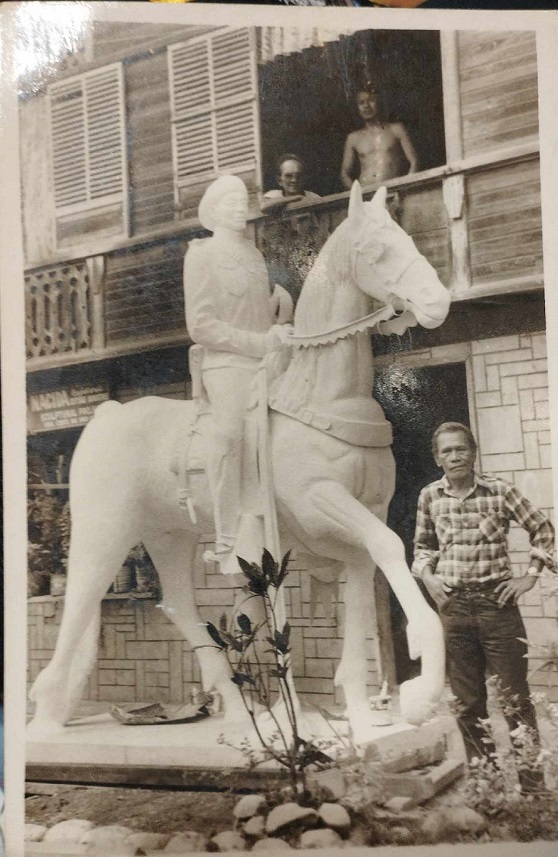Ramon Icayan Cabello was born on November 7, 1919, the third of fiver children of Simeon Ubalde Cabello, a maestro carpintero (master carpenter) and sometimes music composer, and Justa Emanel Icayan, a homemaker, both Lumad Jasaanons of Jasaan, Misamis (later Misamis Oriental).
After finishing his primary school in Jasaan, Ramon started as apprentice carpenter to his father Simeon. Among the legacies of Tatay Guwang (as he was fondly called by his grandchildren) in Jasaan was the Imaculada Concepcion church in Upper Jasaan. Aside from his carpentry, he was also adept at playing a variety of musical instruments, and composed the melody for the Diana, the tune traditionally played by a brass bands to call village folk to prayer during the vísperas leading up to the Jasaan town fiesta.

“Our father showed his proficiency with concrete early when he successfully managed to transfer entire sections of many houses in Jasaan which were affected by road widening projects during the seventies,” recalls his daughter Eusebia Cabello Mendoza, assistant professor III at the Tagoloan Community College, in Baluarte, Tagoloan, Misamis Oriental.

(photo courtesy of Eusebia C. Mendoza)
But it was only a matter of time before he found his calling as a sculptor. His first sculpture was the Imaculada Concepcion image which still stands today in the old community cemetery at Jasaan.
A self-taught sculptor, Tiyoy Ramon (as he was known in Jasaan) used cement as his medium. Because it is cheap, hard, tough, and durable, concrete is particularly suitable for large outdoor projects. With proper reinforcement it permits great freedom of design. And by using techniques similar to those of the building industry, sculptors are able to create works in concrete on a bigger scale.
However, Tiyoy Ramon was what many would call a Do-It-Yourself (DIY) sculptor who developed his sculpting chops as he went along, and used ordinary construction cement as his medium, since he was most familiar with it as a maestro carpintero.
He would first cast a whole cement block for the statue and then carve the image using unusual tools like ordinary cutlery (spoons, forks, and knives), a hatchet, as well as the hammer and chisels from his carpenter’s tools.

(photo courtesdy of Eusebia C. Mendoza)
“He would usually start carving the face based on a photograph he used as reference,” said Mrs. Mendoza. “For finishing he would sandpaper the entire statue. then use white cement to finish the entire statue after all the sculpting works were completed, like what he did with his masterpiece of Misamis Governor Apolinar Velez y Ramos mounted on his horse which graces the front yard of the Misamis Oriental General Comprehensive High School (MOGHS) which he founded in 1909.
Despite his artistry and struggles with his limited tools and resources, Tiyoy Ramon was reportedly paid only the princely sum of P5,000 for every statue he usually sculpted in the silong, or space beneath their house usually used for keeping dogs and chickens.




Nevertheless, he would go on to sculpt a collection of religious statues and monuments of famous Filipino heroes and statesmen like Jose Rizal, Lapu-Lapu, Presidents Manuel Quezon and Ramon Magsaysay, which still dominate the Jasaan town plaza to this day.







Another ensemble work is his Stations of the Cross commissioned by local religious groups, which however, remained unfinished with the last two now overgrown with weeds at the back of the Imaculada Concepcion church.



In Cagayan de Oro, his most famous works are the statue of President Ramon Magsaysay at the Magsaysay Park in Plaza Divisoria (now undergoing renovation), the bust of Girl Scouts of the Philippines Founder Josefa Llanes Escoda at the recently demolished former building of the GSP Misamis Oriental Council next to the Pelaez Sports Center, and the aforementioned monument of Misamis Governor Apolinar Velez y Ramos at the MOGCHS (commissioned by the school’s 1981 Alumni Association headed by President Virgilio V. Neri) unveiled during the 72nd Founding Anniversary & General Alumni Homecoming of the school on March 21, 1981.
It was to be his last obra and he passed away on September 19, 1981. Tiyoy Ramon was married to Lourdes Dael Absin with whom he had seven children, four of who survive to this day.
When one considers how his sculptures dominate the Jasaan town plaza and church landscapes, it is tragic how Ramon Icayan Cabello’s artistry and innovative sculpting techniques remain unrecognized by the Jasaan municipal government, its religious and historical groups 42 years after he passed on.
-30-
